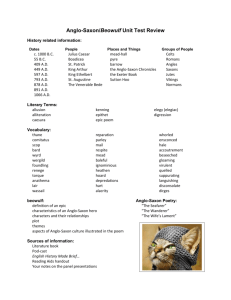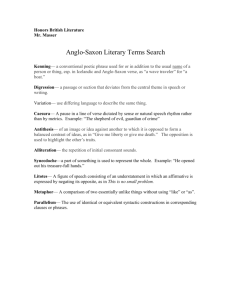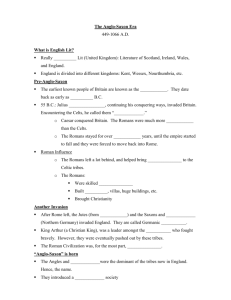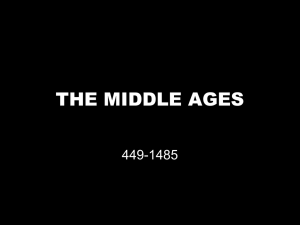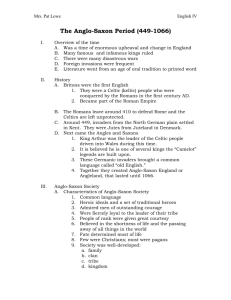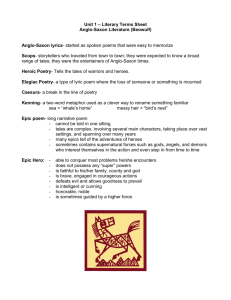12CP British Literature
advertisement
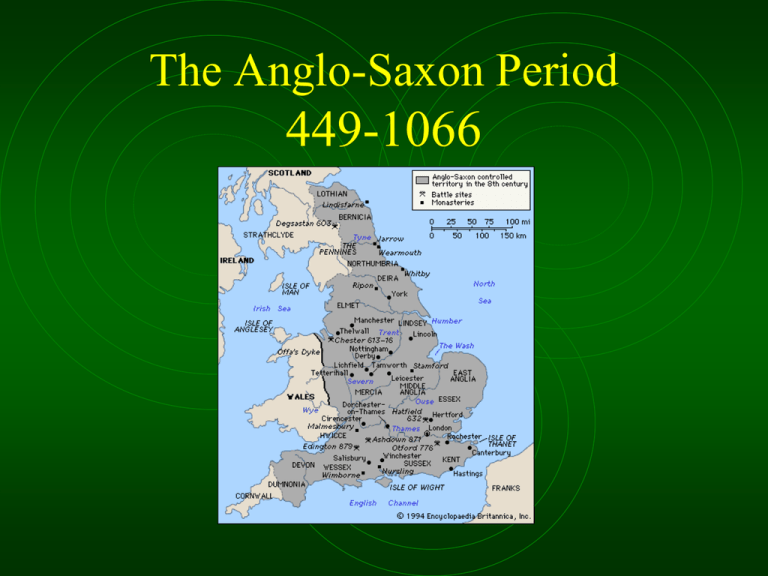
The Anglo-Saxon Period 449-1066 The Very Beginning • 1st-5th c. England= “Britannia” • Province of Roman Empire • Inhabited by Celts; “Britons” & “Gaels” How the “Anglo-Saxon” Period began… • 5th c. (400s) Celts under attack • Romans withdraw • Celts asked for help from the Angles, Saxons, and Jutes (tribes that occupied now-Germany; “Germanic” tribes) • Germanic tribes take over! Beginnings of the Anglo-Saxon Period • Start of English history = invasion of the Angles, Saxons, and Jutes. • “Angle-land.” • The Anglo-Saxons: Lacked written language, supported themselves through farming and hunting, and believed in many different gods. Paganism v. Christianity • Celts initially pagans; converted to Christianity in 4th c.– but after A/S invasion, not really maintained • Anglo-Saxons were also pagans • Late 6th c. (596-597?), missionaries converted the majority of inhabitants to Christianity (but many still held on to pagan beliefs and traditions.) • Christianity=increased literacy The Danish Invasions • 8th and 9th c.-- Other Germanic tribes were invading Britain • By the ninth century, most of England had fallen to the invaders. Alfred the Great • Then, Alfred (king of West Saxons 871-899) saves the day and returns peace to Britain • Enthusiastic patron of literature • Key figure in development of English language The End of the Anglo-Saxon Period • King Edward • King Edward promised the throne to William, Duke of Normandy. However, when he died in 1066, Harold of Wessex claimed the throne. • Harold of Wessex & Duke William of Normandy… The Showdown at the Battle of Hastings • Within a year, William defeats Harold (The Norman Conquest) – William became the first Norman King of England. – Thus the Anglo-Saxon era came to an end. Sutton Hoo • Near Woodbridge, Suffolk • The site of two Anglo-Saxon cemeteries of the sixth and seventh centuries, one of which contains an undisturbed burial including a wealth of artifacts • It sheds light on a period of English history which is on the margin between myth, legend, and historical documentation. The Heroic Code of Excellence • Physical strength • Determination, bravery, courage (reputation important) • Commitment to warfare and acceptance of violence/possible death • Loyalty to fellow warriors, lord, and king– KINSHIP! • Comitatus– the Germanic code of loyalty • Wergild– “man-payment;” paying a slain man’s family to atone for the deed and prevent revenge (failure to get compensation or get revenge was shameful) The Heroic Code of Excellence (continued) • IN RETURN… the king was expected to be generous with gifts of treasure and land, as well as protect his people Themes in Anglo-Saxon Literature • Seafaring warriors, military and tribal loyalties, bravery of warriors, generosity of rulers • Monster-slaying stories from pagan Germanic folklore AND struggles between good and evil from Christian beliefs. Anglo-Saxon Literature • All English spoken, not written, before the conversion to Christianity– oral tradition • Early on, literacy was mainly restricted to the clergy (Latin) • Earliest examples of written English– manuscripts from monasteries • Few examples of texts written in Old English– Beowulf is one of them The Epic and the Epic Hero • Epic- a long, narrative poem that recounts, in formal language, the exploits of a larger-than-life hero. • Epic Hero- the hero of an epic; a character of great importance to his people 6 Characteristics of Epics • 1- Supernatural events and details. • 2- Long time periods. Distant journeys. • 3- Life and death struggles between good and evil. Hero represents good. The forces that threaten the people represent evil. • 4- The defeat of these forces often determines the fate of the nation or group. • 5- To overcome the people’s enemies, the hero requires great physical strength. • 6- He may boast of his strength to his enemies, thus committing himself to courageous action. Language of the Time • Old English -------------- • Two primary sources: • The language of the Celtic people • The language of the invading Germanic tribes • Roughly half of Modern English words are of Germanic origin. Poetic Style of the Anglo-Saxon Period “Oft Scyld Seefing sceapena preatum” • Meter • Four principal stresses in each line • Alliteration • Organizing device of each line; at least one of the two stressed words in the first half-line begin with the first stressed word of the second half-line • Caesura • A natural pause that divides lines of Anglo-Saxon verse into two parts, each with a major stressed syllable; two parts linked to one another through alliteration • Rhyme? Never!! Other Literary Devices Used by the Anglo-Saxons • Kenning: Two-word metaphor to replace a noun (whale-road for ocean; shadow of evil for a monster); it can be hyphenated or use “of” • Synecdoche: part of something used to represent the whole (keel=ship, pages=book) • Metonymy: one thing (usually the material) is used to designate something with which it is commonly associated (iron=sword, copper=penny) • Litotes: ironic understatements (“it wasn’t the first time Grendel came”; “English class at the end of the day had her a little annoyed.”) The Text of Beowulf • • • • • • Oldest of the great long poems written in English Title has been assigned by modern editors Author unknown– probably a single Christian author Date unknown– probably between the 8th and 11th c. Written or oral first? Unknown. 1731– before a modern translation, manuscript damaged in fire– some lost! Welcome to the Anglo-Saxon Unit in British Literature!

